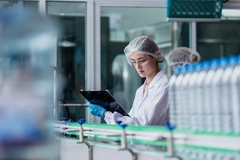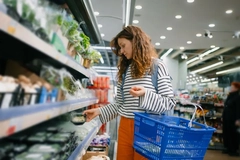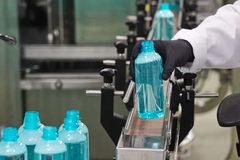E-commerce economics: How can foodservice platforms boost packaging sustainability and profits?

10 Apr 2024 --- Since the COVID-19 pandemic, the scope of e-commerce has expanded from retail to foodservice industry, providing convenience to consumers and new opportunities for restaurants. However, this convenience comes with environmental concerns, particularly regarding packaging waste.
According to the executive director of the Foodservice Packaging Association (FPA), Martin Kersh, even though delivery platforms don’t usually have full control over the packaging used by restaurant and takeaway members, they play an important role in ensuring compliance with legislation and sustainability.
“Meal delivery platforms should do a lot more to ensure their members aren’t exploited by packaging suppliers claiming their packaging has superior environment credentials, when these credentials have no evidence to prove they are legitimate. This includes claims for plastic-free cups, which mostly aren’t plastic free and packaging claiming to be biodegradable when it’s actually compostable only in specialist industrial composting facilities,” Kersh tells Packaging Insights.
“Much packaging claiming to be better for the environment is promoted with made-up symbols, which is in breach of the Green Claims Code. Restaurants and takeaways need to be protected from unscrupulous sellers who exploit their wishes to be ‘more environmental’ in their operations.”
Kersh also stresses that platforms should ensure their members abide by packaging bans. “Too many restaurants and takeaways are using banned expanded polystyrene and extruded polystyrene foam boxes and cups as well as plastic cutlery, which is now masquerading as ‘heavy duty’ or ‘reusable’ when it will actually never be reused.”
“New materials are appearing all the time, but many are sold dishonestly.”
 Xampla highlights its plant-based, plastic free Morro coating for takeaway packaging to address environmental concerns.Strategic reductions and switches
Xampla highlights its plant-based, plastic free Morro coating for takeaway packaging to address environmental concerns.Strategic reductions and switches
Collaboration emerges as a key theme in food e-commerce, with stakeholders across the food delivery ecosystem, including brands, restaurants, delivery platforms and regulators, coming together to address packaging waste.
“From implementing ‘opt-in or out’ options for cutlery on their delivery platforms to creating educational materials for their restaurants, [online food delivery platforms] can engage their merchants and restaurants in reducing packaging waste,” Carolina Lobel, senior director at Closed Loop Partners’ Center for the Circular Economy, tells Packaging Insights.
“A suite of upstream and downstream solutions is needed — including designing for material reduction, as well as advancing well-designed reuse, recycling and composting systems –– to mitigate unintended consequences of new solutions and help avoid waste across the value chain.”
Meanwhile, Xampla’s chief technical officer Marc Rodriguez Garcia tells us: “There is a growing shift in online food delivery packaging away from synthetic materials toward natural options. Plant-based solutions offer a natural alternative that addresses environmental and health concerns of manufacturers and brands.”
“As regulatory scrutiny increases, forward-looking brands are exploring plant-based, plastic-free solutions that sit outside the scope of the EU Single-Use Plastic Directive (SUPD).”
No reuse for QSRs?
While there is growing interest in reusable packaging solutions for foodservice, challenges persist in implementing effective reuse systems.
Michael Hoffmann, vice president of sustainability and communications for Fiber Foodservice EMEA-Asia-Oceania at Huhtamaki, tells Packaging Insights: “There’s a noticeable push toward reducing plastic content within products, especially in QSR food delivery. Some stakeholders are urging us to move toward plastic-free options. We’re innovating to meet these demands.”  Huhtamaki is innovating to meet the demands for plastic reduction and elimination.
Huhtamaki is innovating to meet the demands for plastic reduction and elimination.
“While we are not against reuse, it doesn’t align well with the demands of QSR food delivery. The logistical complexities and high cost, coupled with branding considerations, pose significant challenges. Studies also indicate that reusable models may not offer the environmental benefits they promise, with escalating emissions and water consumption over time.”
“Data from various studies suggests reusables will emit more than 2.8 times CO2 and consume 3.4 times more fresh water. If you bring in, for example, a reuse model, you’re also introducing significant amounts of additional plastic. The No Silver Bullet report indicates that reuse would result in 16 times more plastic for takeaway packaging,” shares Hoffmann.
Furthermore, the Huhtamaki Fiber Foodservice sustainability vice president warns of increasing cost to the value chain with the introduction of reuse systems.
“If you were to introduce reuse systems across the EU for QSR, you’re looking at an additional cost of €15–20 billion (US$16–21 billion). And that would naturally have to be passed on to the consumer. In times of high inflation, that would send a huge shock wave to too many consumers,” says Hoffmann.
Food safety fight
Larissa Copello, Packaging & Reuse policy officer at Zero Waste Europe (ZWE), tells us that packaging for takeaway and delivery comes with a “huge” cost for the environment and municipalities which have to deal with management and litter.
“We’ve seen an increasing shift toward paper-based packaging in the past five years, especially after the adoption of the EU SUPD. Nevertheless, this packaging contains plastics in its majority and is also included in the scope of the SUPD. In addition, it contains very nasty chemicals that are bad for our health and environment,” warns Copello.
Xampla’s Garcia explains that traditional paper and cardboard takeaway boxes are commonly coated in either petrochemical-based or fluorochemical materials to protect and preserve produce. “These coatings do not fully biodegrade and can disrupt the recycling process, contributing to environmental pollution.”
 From implementing ‘opt-in or out’ options for cutlery to creating educational materials for restaurants, food delivery platforms can engage their merchants in reducing packaging waste, says Lobel.“Companies must comply with regulations aimed at reducing single-use plastics. Plastic and PFAS are coming under increasing scrutiny regarding health consequences. To ensure compliance across regions, companies can stay ahead of the curve of regulatory requirements by investing in adopting natural, plastic-free solutions now.”
From implementing ‘opt-in or out’ options for cutlery to creating educational materials for restaurants, food delivery platforms can engage their merchants in reducing packaging waste, says Lobel.“Companies must comply with regulations aimed at reducing single-use plastics. Plastic and PFAS are coming under increasing scrutiny regarding health consequences. To ensure compliance across regions, companies can stay ahead of the curve of regulatory requirements by investing in adopting natural, plastic-free solutions now.”
Nathan Dufour, reuse systems manager at ZWE, adds: “Paper and board are the second most used type of Food Contact Materials (FCMs) in Europe, superseded only by plastics. However, specific EU legislation for paper and board FCMs does not exist. Single-use fiber-based packaging almost systematically can contain a variety of additives for functionality, (e.g., grease-proofing agents), many of them being harmful to human health.”
“Additionally, the use of recycled materials potentially creates new pathways through which humans can be exposed to hazardous chemicals in contaminated material flows, as shown, for example, in the recent report from the human biomonitoring consortium (HBM4EU), where bisphenols and phthalates were found in recycled paper used for food packaging.”
“We need to secure ambitious laws that ensure products and packaging are long-lasting, reusable and toxic-free. There’s no straightforward answer on chemicals and packaging materials since it will depend on the application,” underscores Dufour.
Hygiene and convenience
Kersh at FPA says that reusable packaging will only work if it is part of a controlled system, which must ensure packaging is returned — otherwise, any environmental benefit is lost, and matters worsen.
But, he questions: “Is the packaging to be returned to the restaurant or the meal delivery platform?”
“On average, households are said to order from an individual restaurant or takeaway just four times a year as they seek variety. For a restaurant to come back to collect reusable packaging is not environmentally justified or economically feasible. The delivery platform will, therefore, need to make arrangements for its return. But will they require a waste carrier’s license if they collect it?”
“[Returned reusable delivery packaging] will certainly need to be kept separate from other food being delivered. The FPA is concerned that tests of reusable packaging outside closed environments have been poorly conducted and on too small a scale for the results to be meaningful,” remarks Kersh.
Meanwhile, Lobel at Closed Loop Partners foresees an increasingly important role for reusable packaging as more businesses consider alternatives to single-use packaging. The Foodservice Packaging Association executive director says meal delivery platforms should do a lot more to ensure their members aren’t exploited by packaging suppliers.
The Foodservice Packaging Association executive director says meal delivery platforms should do a lot more to ensure their members aren’t exploited by packaging suppliers.
“To build successful reuse systems, offering convenient and widespread options for customers to return their containers will be critical. Testing reuse in the market is critical in ensuring reuse can scale responsibly and meet the growing demand for waste mitigation solutions. There’s a major gap that delivery companies can help fill by leveraging their last-mile delivery infrastructure for packaging collection, effectively enabling delivery packaging to be put back into circulation.”
Recovering materials challenge
Experts highlight continuous innovation and investment in packaging design, recycling infrastructure and delivery logistics as imperative for driving sustainable practices within the industry.
“A major challenge impacting eliminating plastic from packaging materials is the perception that it requires costly investment in new machinery. However, advancements in technology, such as Xampla’s drop-in technology, enable natural materials to be produced on the same manufacturing lines as their synthetic predecessors, making scalability feasible and requiring no additional investment in machinery,” Xampla’s Garcia clarifies.
Lobel at Closed Loop Partners says: “Efforts to reduce packaging waste in the online food delivery space are growing, driving changes around material used for packaging, as well the systems that facilitate the movement of packaging through the supply chain.”
“As more new materials enter the stream, it is critical to identify opportunities for more robust recycling and composting infrastructure and invest in upgrading and scaling capacity to ensure that valuable materials are recovered and pulled back into supply chains at end-of-life.”
“Packaging certifications and labeling also play an important role in ensuring proper recovery at end-of-life,” Lobel continues.
Kersh adds: “There will inevitably be an increased focus on sustainability, though without anyone defining what sustainability is.”
“We also want to see improvements in packaging that will keep food hotter and in the correct condition to improve customers’ enjoyment of delivered meals.”
By Radhika Sikaria











